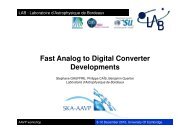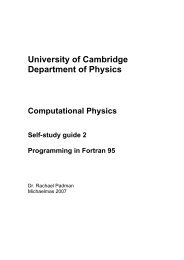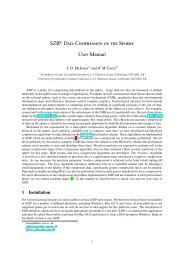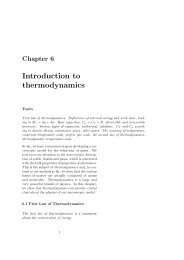Bayesian Methods for Astrophysics and Particle Physics
Bayesian Methods for Astrophysics and Particle Physics
Bayesian Methods for Astrophysics and Particle Physics
You also want an ePaper? Increase the reach of your titles
YUMPU automatically turns print PDFs into web optimized ePapers that Google loves.
2.2 Introduction<br />
as a multivariate Gaussian centred at its peak (see e.g. Hobson et al. 2002),<br />
but this approximation is clearly a poor one <strong>for</strong> multimodal posteriors (except<br />
perhaps if one per<strong>for</strong>ms a separate Gaussian approximation at each mode). The<br />
Savage–Dickey density ratio has also been proposed (Trotta 2005) as an exact,<br />
<strong>and</strong> potentially faster, means of evaluating evidences, but is restricted to the<br />
special case of nested hypotheses <strong>and</strong> a separable prior on the model paramet-<br />
ers. Various alternative in<strong>for</strong>mation criteria <strong>for</strong> astrophysical model selection are<br />
discussed by Liddle (2007), but the evidence remains the preferred method.<br />
The nested sampling approach (Skilling 2004) is a Monte Carlo method tar-<br />
getted at the efficient calculation of the evidence, but also produces posterior<br />
inferences as a by-product. In cosmological applications, Mukherjee et al. (2006)<br />
showed that their implementation of the method requires a factor of ∼ 100 fewer<br />
posterior evaluations than thermodynamic integration. To achieve an improved<br />
acceptance ratio <strong>and</strong> efficiency, their algorithm uses an elliptical bound contain-<br />
ing the current point set at each stage of the process to restrict the region around<br />
the posterior peak from which new samples are drawn. Shaw et al. (2006b) point<br />
out, however, that this method becomes highly inefficient <strong>for</strong> multimodal pos-<br />
teriors, <strong>and</strong> hence introduce the notion of clustered nested sampling, in which<br />
multiple peaks in the posterior are detected <strong>and</strong> isolated, <strong>and</strong> separate ellipsoidal<br />
bounds are constructed around each mode. This approach significantly increases<br />
the sampling efficiency. The overall computational load is reduced still further<br />
by the use of an improved error calculation (Skilling 2004) on the final evidence<br />
result that produces a mean <strong>and</strong> st<strong>and</strong>ard error in one sampling, eliminating the<br />
need <strong>for</strong> multiple runs.<br />
In this study, we build on the work of Shaw et al. (2006b), by pursuing further<br />
the notion of detecting <strong>and</strong> characterizing multiple modes in the posterior from<br />
the distribution of nested samples. In particular, within the nested sampling<br />
paradigm, we suggest three new algorithms (the first two based on sampling from<br />
ellipsoidal bounds <strong>and</strong> the third on the Metropolis algorithm) <strong>for</strong> calculating the<br />
evidence from a multimodal posterior with high accuracy <strong>and</strong> efficiency even when<br />
the number of modes is unknown, <strong>and</strong> <strong>for</strong> producing reliable posterior inferences<br />
in this case. The first algorithm samples from all the modes simultaneously <strong>and</strong><br />
provides an efficient way of calculating the ‘global’ evidence, while the second <strong>and</strong><br />
19






